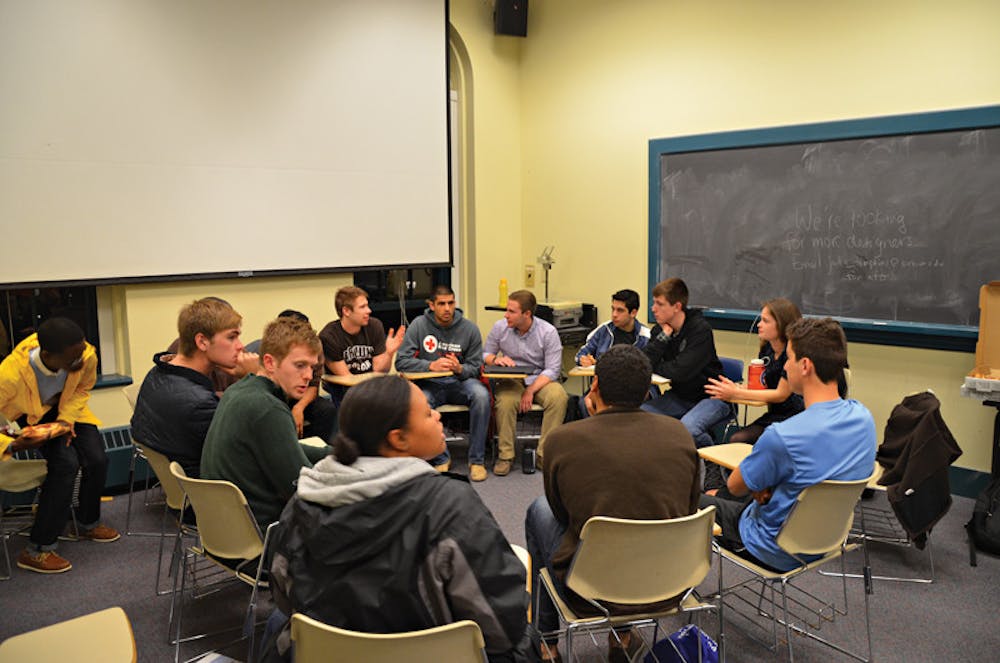“The right to speech should not go to whoever shouts the loudest,” said Brian Hasegawa ’18, one of about 60 students present at the Brown Political Forum’s discussion on hate speech and safe spaces Monday night.
The event, titled “Who Has the Right to Speak? Hate Speech and ‘Self-infantilization’ on College Campuses,” took place in a crowded Salomon 203 and was co-sponsored by the campus chapter of the American Civil Liberties Union.
Through inclusive dialogue among community members with varied perspectives, students in attendance explored issues regarding the role the University plays in restricting or enabling speech, as well as the effectiveness of safe spaces on college campuses.
“BPF is all about providing a safe space,” said Vice President of BPF Shreya Bhargava ’15. A safe space is “a place where you can have healthy discourse. This discussion was just an attempt on our part to have students express their opinions and feel free to discuss their opinions,” she added.
Both hate speech and safe spaces on college campuses have recently been scrutinized in the national media. Bryce Campanelli ’18 opened the discussion with reference to a few incidents involving hate speech that have occurred on college campuses across the country, most notably the suspension of two University of Oklahoma fraternity members who were videotaped chanting racial slurs.
Campanelli also mentioned Judith Shulevitz’s March 21 New York Times op-ed, “In College and Hiding From Scary Ideas,” in which the columnist expressed concern over a growing culture of “self-infantilization” on college campuses.
Contrary to the typical format of BPF’s discussion forums where students are initially assigned opinions to discuss in small groups, at Monday’s event, students were asked to separate into four groups and engage in conversation “with actual views in mind” due to the complexity of the issues.
In one group, there was initial confusion as to what a safe space was. Students debated whether a safe space constitutes a separate physical space for support or if it refers more abstractly to a discussion with rules that ensure attendees do not feel uncomfortable. Despite these existing discrepancies, group members reported back to the larger discussion that many students agreed that safe spaces have a place on campus.
But there was more disagreement when the conversation later explored how safe spaces could discourage people from sharing their opinions. “It creates an atmosphere where people are petrified of saying something that could make someone go to a safe space,” one student in attendance said. He added that people could think “they’ve done something wrong by voicing an opinion or being controversial” after saying something that is triggering for someone else.
Heated arguments arose when the larger group set out to discuss lectures and debates held on campus. Many students referred to the events surrounding former New York City Police Commissioner Ray Kelly’s scheduled talk in October 2013. While some thought protesters unjustly prevented Kelly from speaking, others took issue with Kelly’s being invited to give a lecture on campus in the first place.
“Speech can be harmful,” said Malik Jarvis ’18, adding that people can sometimes internalize and normalize what is said, causing “negative externalities” such as the rise of contagious diseases in the case of the anti-vaccination movement and the promotion of rape culture.
Campanelli highlighted the benefits in hearing opinions that may differ from your own. “I want my school to bring in speakers who will challenge me to think in ways that I totally don’t agree with and because of that, then I can grow.”
The discussion exceeded the allotted time of an hour.
“It was great to hear the different perspectives we had throughout the room,” Bhargava said. “That’s all what healthy discourse is about — listening to people with different points of view. I hope most people who attended the discussion have a broader perspective and can make better and well-informed decisions about hate speech and the topics that we discussed today.”





